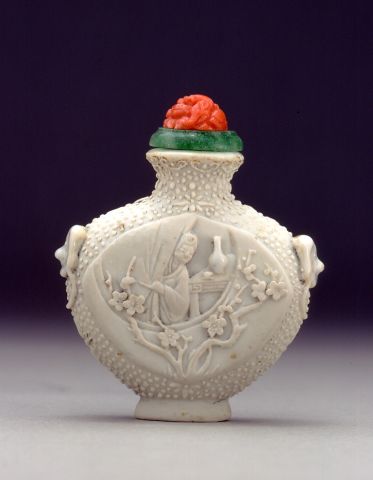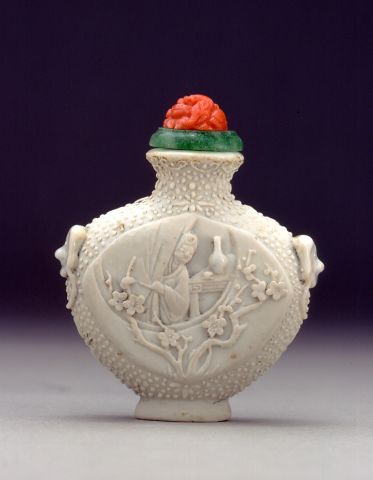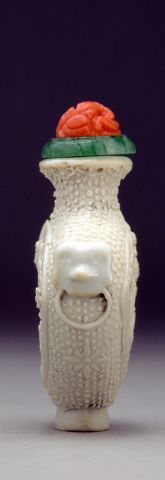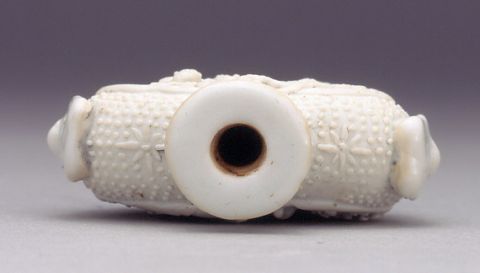



Bottle ID: 631
CHILDREN IN GARDEN, WITH GLAZED PEACH AND HANDLES
Date: 1820-1949
Height: 47 mm
Porcelain with a transparent glaze, of flattened hu form with a flared neck each and everted mouth, each main side with a foliate panel with the design in bas-relief, one side with two children playing in a garden beneath a pine tree, one holding what appears to be a jar behind his back as he approaches the other boy, who is also holding something in his hand; and on the other main side with a young woman, pulling back the curtain of a circular window and gazing out onto a flowering prunus tree, with a vase and a cup and saucer on a table behind her, the panels surrounded by a pattern of two formalized flower-heads, one set low on each narrow side amidst raised dots, the underside of the upper neck-rim with a band of formalized lingzhi-heads, the shoulders with animal-mask and ring handles, the lip, mask-and-ring handles and the underside of the foot all glazed, the rest biscuit, the interior unglazed.
Attributed to Jingde Zhen.
Similar Examples:
Sotheby's, London, June 21, 1995, lot 135, Collection of the Stone Picking Studio [Cai Shi Xuan].
Sotheby's, New York, September 15, 1998, lot 174, The Neal W. and Frances R. Hunter Collection.
Provenance:
Hugh Moss (HK) Ltd
Robert Hall, September 2004
Sotheby's, New York, July 1, 1985, lot 2
The Kardos Collection
Arthur Loveless
Exhibited:
Anthropological Museum, U.B.C., Vancouver, 1977
Among the mid-Qing types of snuff bottles made at Jingde Zhen was a glazed group with a raised-dot pattern, known as 'chicken-skin', surrounding a main subject, either as a ground or, more frequently as surrounding panels. They can be dated from the late Qianlong period, and and at that point attributed to the Palace Kilns. There is, for instance, in the Bragge Album of hand-coloured water-colours of the William Bragge Collection, a Qianlong marked 'dragon' bottle with a blue, raised-dot ground of this sort. The writing of the reign mark with one incorrect character suggests that it was made during the period from 1796 to 1799 when the Emperor had abdicated and before he died. Another, in the same album, with the same reign mark was possibly not for Imperial use since it only has a two character mark and is a more standard version, with famille rose enamels on a green stippled ground and standard panels of decoration. An early version of the type, with Imperial poems in gold panels followed by the Qianlong Emperor’s seals is in Zhao Ruzhen, Jianbian biyanhu, p.65, no.71, where the pale, turquoise-blue stippled ground of the surround has raised gold details, suggesting a stylistic origin from painted enamels on metal from the Palace Workshops in the early Qianlong period. They also appear in a similar range of shapes to this one with flat panels of painted enamels, and stippled surrounds, and with the same small, animal-handles which are typical of the mid-Qing, from the late Qianlong onwards. During the Jiaqing period a shift took place at Jingde Zhen from unglazed to glazed interiors for the standard Imperial and common bottles produced, and by the Daoguang period unglazed interiors became the exception rather than the rule. This is a rare example of the group where only some areas are glazed, the rest being left in biscuit porcelain. Whilst it has been suggested that this argument proves that this bottle could be from the Eighteenth century, making it the earliest known carved piece of unglazed porcelain, it is also quite possible that it was produced a century later copying the earlier masters, Chen Guozhi, Wang Bingrong and Li Yucheng. Although carved porcelain existed in China, it re-emerged only during the nineteenth century as biscuit carved porcelain. The few snuff bottles with Jiaqing dates tend to be accepted as correct with the Xinquan bottle in this collection (Crane no. 358) being accepted as the earliest known dated piece. Most pieces which are marked have either Daoguang or Guangxu marks, no pieces are known with Xianfeng reign marks and very few with Tongzhi. This gap in dated pieces was probably as a result of the Taiping Rebellion which lasted from 1850-1864. In 1855 Jingde Zhen was overrun by rebels and the kilns were destroyed as well as the city being de-populated. In addition to this, one of the earliest credible references to biscuit porcelain in in 1815, during the Jiaqing Period. Lan Pu (Lan pingnan) in Jingdezhen taolu (an account of Jingdezhen pottery) mentions that the best clay for carving is not suitable for glazing. At this time the different techniques of decoration were divided amongst trained specialists so that one potter might do embossing whilst another would do engraving or carving.
< Back to full list
 English
English 中文
中文